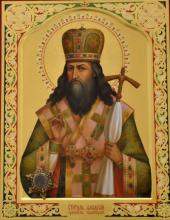5/18 February
 The future holy hierarch was born at the beginning of the 1630s, in the province of Podolsk. He was of the lineage of the ancient aristocratic Polonitsky-Uglitsky family. His parents were Priest Nikita and Maria. The piety which ruled in the family of the future holy hierarch benefited the child’s spiritual development. From childhood, he excelled in humility and devotion to prayer. The youth’s natural capacities blossomed in the Kiev-Bratsk College at the Kiev Theophany Monastery. This was at the close of the 1640s, when the college was at its zenith.
The future holy hierarch was born at the beginning of the 1630s, in the province of Podolsk. He was of the lineage of the ancient aristocratic Polonitsky-Uglitsky family. His parents were Priest Nikita and Maria. The piety which ruled in the family of the future holy hierarch benefited the child’s spiritual development. From childhood, he excelled in humility and devotion to prayer. The youth’s natural capacities blossomed in the Kiev-Bratsk College at the Kiev Theophany Monastery. This was at the close of the 1640s, when the college was at its zenith.
St. Theodosius’ calling to the monastic path was confirmed during his school years. He spent all of his free time in prayer, in contemplation of God, and in reading of the Divine Scriptures.
After his schooling, the future holy hierarch accepted monastic tonsure in the Kiev Caves Lavra. He was given the name Theodosius, in honor of Venerable Theodosius (commemorated 3 May).
In 1662, St. Theodosius was appointed abbot of the Korsun Monastery in the diocese of Kiev, and in 1664, rector of the ancient Kiev-Vydubitsk Monastery. Shortly before this took place, the monastery had been in the hands of the Uniates and had been utterly devastated. Thanks to his energy and persistence, St. Theodosius succeeded in quickly reestablishing the Vydubitsk Monastery of St. Michael. He took special care with respect to proper church order. The holy abbot, a strict ascetic, strove to promote the spiritual growth of the residents of the monastery. In 1680, he established a small skete on the island of Mikhailovschino, not far from the monastery, for those brethren who wished to live in isolation. During his tenure as abbot of the Kiev-Vydubitsk Monastery, Holy Hierarch Theodosius endured very difficult times. Methodius, bishop of Mstislav and Orshansk, accused him and other abbots of betraying the Russian government and of corresponding with traitors. On September 20, 1668, St. Theodosius was required to explain the matter. On November 17, 1668, it was learned that the accusations were slanderous, and the holy hierarch and the other abbots were pardoned. The Most-reverend Lazar (Baranovitch) recognized St. Theodosius’ great spiritual qualities, and established close ties with him. Calling him “a lamb of Christ’s flock, learned in obedience,” he expressed the prophetic wish that St. Theodosius’ name would be written in the Heavens.
In 1688, St. Theodosius was appointed archimandrite of the Chernigov Yeletsk Monastery. His appointment was primarily at the behest of Most-reverend Lazar. St. Theodosius had to expend much effort to set the Yeletsk Monastery in order, for the monastery, not yet recovered from its desolation at the hands of the Jesuits and Dominicans, was quite poor and disorganized. Within two or three years, though, through the assiduous efforts of St. Theodosius, the Yeletsk Monastery had improved to the point that its continued existence was assured.
On September 11, 1692, with great pomp, St. Theodosius was consecrated archbishop in the Dormition Cathedral in the Moscow Kremlin.
The holy hierarch focused special attention on awakening and maintaining in his flock a spirit of true Christian piety. With this in mind, he endeavored to maintain the old monasteries and churches, and to see that new ones were established. During St. Theodosius’ tenure in the Chernigov diocese, there was a notable upsurge in and strengthening of monasticism. The holy hierarch also paid great attention to the clergy, and showed sharp discernment in the selection of candidates for the priesthood. He lent particular support to Chernigov’s religious schools, inviting to them learned monks from Kiev, including St. John Maximovitch (future metropolitan of Tobolsk), who became the holy hierarch’s assistant, successor, and organizer of religious schools in Chernigov. Among St. Theodosius’ remarkable qualities were his rigorous fairness in dealing with clergy and flock, his profound sympathy, his tolerance, and his Christian peaceable disposition. Not only Orthodox people, but also people of other faiths turned to him for help and counsel.
St. Theodosius did not nourish the Chernigov flock for very long, though. Sensing his coming death, he summoned to Chernigov St. John Maximovitch, administrator of the Bryansk Svena Monastery, and elevated him from hieromonk to archimandrite of the Chernigov Yeletsk Monastery. In the person of the new archimandrite, he was grooming his successor. On February 6, 1696, Holy Hierarch Theodosius reposed. He was interred in a specially built crypt behind the right kliros of the Chernigov Cathedral of Ss. Boris and Gleb. St Theodosius’ ascetic way of life and the secret help which he has extended to all who raise up prayers to him bear witness to the grace-filled gifts he acquired.
The glorification of Holy Hierarch Theodosius took place on September 9, 1896.
